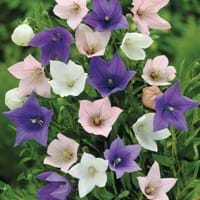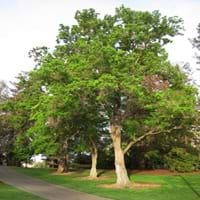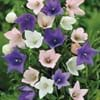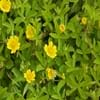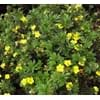Life Span
Perennial
Perennial
Type
Flowering Plants, Herbs, Perennial
Tree
Origin
China, Eastern Asia, Japan
Eastern Asia, China
Types
Platycodon grandiflorus Astra series, Platycodon grandiflorus Fuji series, Platycodon grandiflorus 'Komachi', Platycodon grandiflorus 'Sentimental Blue'
Candleberry tree
Number of Varieties
Not Available
Habitat
Grassland, Hillside
Saline Soils, Upland, Upland soils
USDA Hardiness Zone
3-8
8-10
Sunset Zone
A1, A2, A3, H1, H2, 1a, 1b, 2a, 2b, 3a, 3b, 4, 5, 6, 7, 8, 9, 14, 15, 16, 17, 18, 19, 20, 21, 22, 23, 24
H2, 8, 9, 12, 13, 14, 15, 16, 18, 19, 20, 21
Habit
Clump-Forming
Oval or Rounded
Minimum Height
Not Available
Minimum Width
Not Available
Flower Color
White, Blue, Pink
Yellow
Flower Color Modifier
Not Available
Bicolor
Fruit Color
Not Available
White, Ivory
Leaf Color in Spring
Green, Sea Green
Green
Leaf Color in Summer
Green, Sea Green
Green
Leaf Color in Fall
Green, Sea Green
Yellow, Red, Orange
Leaf Color in Winter
Light Green
Not Available
Leaf Shape
Cushion
Heart-shaped
Plant Season
Summer, Fall
Spring, Summer, Fall
Sunlight
Full Sun, Partial Sun
Full Sun
Type of Soil
Loam, Sand
Clay, Loam, Sand
The pH of Soil
Acidic
Acidic, Neutral, Alkaline
Soil Drainage
Well drained
Average
Bloom Time
Summer, Late Summer, Early Fall, Fall
Spring
Tolerances
Drought
Cold climate, Drought, Pollution, Salt
Where to Plant?
Container, Ground, Pot
Ground
How to Plant?
Divison, Seedlings, Seperation
Grafting, Seedlings, Stem Planting, Transplanting
Plant Maintenance
Medium
Medium
Watering Requirements
Average Water Needs
Average Water Needs, Medium, Requires watering in the growing season
In Summer
Lots of watering
Lots of watering
In Spring
Moderate
Moderate
In Winter
Average Water
Average Water
Soil pH
Neutral
Acidic, Neutral, Alkaline
Soil Type
Loam, Sand
Clay, Loam, Sand
Soil Drainage Capacity
Well drained
Average
Sun Exposure
Full Sun, Partial Sun
Full Sun
Pruning
Prune in spring, Prune in summer, Remove damaged leaves, Remove dead leaves, Remove dead or diseased plant parts
Remove damaged leaves, Remove dead leaves, Remove dead or diseased plant parts, Remove deadheads
Fertilizers
All-Purpose Liquid Fertilizer
fertilize in growing season, Less fertilizing, Nitrogen
Pests and Diseases
Slugs, Snails
Insects, Red blotch
Plant Tolerance
Drought
Cold climate, Drought, Salt
Flowers
Showy
Insignificant
Flower Petal Number
Single
Single
Foliage Texture
Medium
Medium
Foliage Sheen
Matte
Matte
Attracts
Birds
Not Available
Allergy
Asthma, Skin rash
Nausea, Toxic, Vomiting
Aesthetic Uses
Beautification, Showy Purposes
Landscape Designing
Beauty Benefits
Not Available
No Beauty Benefits
Environmental Uses
Air purification
Absorbs greenhouse gases, Absorbs huge amounts of CO2, Air purification, Amazing growth rate, Erosion control, Food for insects, Forms dense stands, Nesting sites for birds, No fertilizer, pesticides, or herbicides needed, Prevent Soil Erosion, Shadow Tree, Shelter for wildlife, Soil protection, soil stabilisation, Used to establish native woodland, Very little waste, Wildlife, Windbreak
Medicinal Uses
anti-allergy, Antibacterial, anti-cancer, anti-inflammatory, Asthma, Bronchitis, chest congestion, Cold, Cough, Diabetes, improved insulin resistance, Sore throat, Tonsillitis, tuberculosis
Boils
Part of Plant Used
Whole plant
Fruits, Leaves, Seeds
Other Uses
Used As Food
Employed in herbal medicine, Showy Purposes, Used as firewood, Used for its medicinal properties
Used As Indoor Plant
No
No
Used As Outdoor Plant
Yes
Yes
Garden Design
Container, Cutflower, Mixed Border
Feature Plant, Shade Trees, Street Trees
Botanical Name
PLATYCODON grandiflorus( Apoyama Group)
TRIADICA sebifera
Common Name
Balloon Flower
Chinese Tallow
In Hindi
Balloon flower
चीनी तेल
In German
Ballonblume
chinesisch Talg
In French
balloon Flower
chinesisch Talg
In Spanish
globo de planta de flor
suif chinois
In Greek
μπαλόνι εργοστάσιο λουλούδι
κινέζικο ζωικό λίπος
In Portuguese
Balão flor planta
sebo chinesa
In Polish
Balon kwiat roślin
chiński łój
In Latin
balloon flos plant
Chinese adipe
Phylum
Embryophyta
Embryophyta
Class
Dicotyledonae
Magnoliopsida
Order
Asterales
Malpighiales
Family
Campanulaceae
Euphorbiaceae
Genus
Platycodon
Triadica
Clade
Angiosperms, Asterids, Eudicots
Angiosperms, Eudicots, Rosids
Tribe
Not Available
Hippomaneae
Subfamily
Not Available
Euphorbioideae
Number of Species
Not Available
Not Available
Importance of Balloon Flower and Chinese Tallow
Want to have the most appropriate plant for your garden? You might want to know the importance of Balloon Flower and Chinese Tallow. Basically, these two plants vary in many aspects. Compare Balloon Flower and Chinese Tallow as they differ in many characteristics such as their life, care, benefits, facts, etc. Every gardener must at least have the slightest clue about the plants he wants to plant in his garden. Compare their benefits, which differ in many ways like facts and uses. The medicinal use of Balloon Flower is anti-allergy, Antibacterial, anti-cancer, anti-inflammatory, Asthma, Bronchitis, chest congestion, Cold, Cough, Diabetes, improved insulin resistance, Sore throat, Tonsillitis and tuberculosis whereas of Chinese Tallow is Boils. Balloon Flower has beauty benefits as follows: Not Available while Chinese Tallow has beauty benefits as follows: Not Available.
Compare Facts of Balloon Flower vs Chinese Tallow
How to choose the best garden plant for your garden depending upon its facts? Here garden plant comparison will help you to solve this query. Compare the facts of Balloon Flower vs Chinese Tallow and know which one to choose. As garden plants have benefits and other uses, allergy is also a major drawback of plants for some people. Allergic reactions of Balloon Flower are Asthma and Skin rash whereas of Chinese Tallow have Nausea, Toxic and Vomiting respectively. Having a fruit bearing plant in your garden can be a plus point of your garden. Balloon Flower has no showy fruits and Chinese Tallow has no showy fruits. Also Balloon Flower is not flowering and Chinese Tallow is not flowering . You can compare Balloon Flower and Chinese Tallow facts and facts of other plants too.
